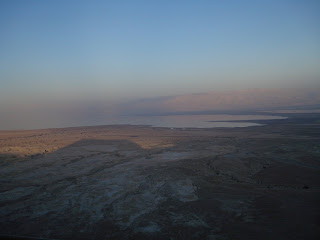This post recounts the single most defining experience of my trip. Building on my thoughts from last time, I wrote a journal entry on the cliffs descending from Massada. I’ve given a historical overview of Massada for those who are unfamiliar. If you don’t know the story, I encourage you to read it here – it is as inspiring as it is awful.
History of Massada – the Great Revolt
The Israelites of Judea revolted against the Roman empire in 66 CE, and 70 CE marks what may have been the greatest tragedy of Jewish history until the Holocaust: the destruction of the 2nd temple in Jerusalem. Massada, a great fortress on steep cliffs overlooking the Dead sea, was the Israelite’s final stronghold. Under Roman siege, the rebels (Sacarii) came to face certain defeat in 74 CE. Rather than become enslaved to the Romans, which they say as a form of Idolatry, they chose to take their lives.
Except for a few survivors, the nearly 1000 inhabitants took their lives. They drew lots to determine which ten men would die last, the same ten charged with supervising the communal suicide. They set their city ablaze as they begun to take their lives, the ten unlucky men drew final lots to see who kill the others and take his life last…
Reflection From my Notebook:
I sit cross-legged on the cliffs of Massada, gazing east over the Dead Sea and Jordanian mountains just beyond. Massada casts a growing shadow over the floodplain below. I calmly anticipate the mountains becoming awash in soft pastel hues of red and blue, as twilight descends over the Judean Desert. Having climbed Massada twice today, I pause to reflect before completing my descent to the floor of the Syrian-African rift valley, the lowest point on Earth.
The ruins of a Roman army camp, and an accompanying siege wall, are visible below. The legion, 8000 strong, sought to enslave heroic Sacarii (rebels) who bitterly held on to their Jewish dignity, taking their lives on the summit above the cliffs upon which I ponder their bravery.
We climbed the mountain before dawn broken this morning, and watched the sun rise as we ascended. Upon reaching the top, I immediately grinned when I saw an Israeli flag blowing in the cool wind. Nearly 2000 years after the Roman empire defeated the Sacarii, Israel has reclaimed this land for the Jewish people.
During my second ascent, I passed a sign that kindly reminded me not to enter Israeli Defense Force firing zones. The reality of continuing conflict struck me in a terribly real way.
Israel is a land of great struggles, of revolts, crusades, empires and lost hope. But it is also a holy land, a land of celebration, joy, worship, rich history, and stunning natural beauty.
I am perched, profoundly alone, in a liminal place. I am halfway up the mountain, a Roman camp below and the great fortress above. I am struck by the continue history of struggles that pervades Israel. Indeed, Israel literally means to “struggle” or “strive”.
The Dead Sea is shrinking and disputed borders criss-cross the land. The desert blooms as the Kinneret shrinks.
Israel is a land of Divine endowment, and the Divine image reflects core values held by the Jewish people for 1000s of years. Indeed, I believe that man created G-d, and not the reverse. Perhaps holiness is a spectrum, and we must do all we can to foster an Israel that reflects its humbling history.
Pictures (top down):
1) The new cover picture of my blog goes comes with this post, and there is a caption below it.
2) The view from the ledge where I wrote my journal entry, the entry that I transcribed into this blog post.
3) A massive water cistern, with my friend Amanda for scale. About 1/3 of the room is visible, and there were several other cisterns this large. The inhabitants captured flood and rainwater, and even had a large public pool! There were also Roman-style baths, public immersion pools, and ritual baths (mikvehs).
4) The rebels raised doves in these little cubbies, and used them for meat. My Hebrew name is “Doved” (shortens to “Dove”) so I got a little bit worried… It seems bizarrely humorous that rebels would raise birds of peace for slaughter…
5) This was the take-home view from my second hike. Parents: STOP reading now! At the edge of the path ahead, there was a steep drop-off, and for about 30 minutes I was walking along sheer precipices. From here, I could see the ridge connecting me to west side of Massada. The Roman ramp is visible just past the ridge, the ramp from which the legion made their final assault.
6) Taking preservation too far? All of the walls below the black are original, and those above are restored. Instead of constructing separate bathrooms, they actually built the restroom right up to the edge of the ruins. I’m not sure how I feel about this, but it is certainly tickling.









I loved Massada too. We made it up just as the sun rose and it was such a peaceful place.
ReplyDelete